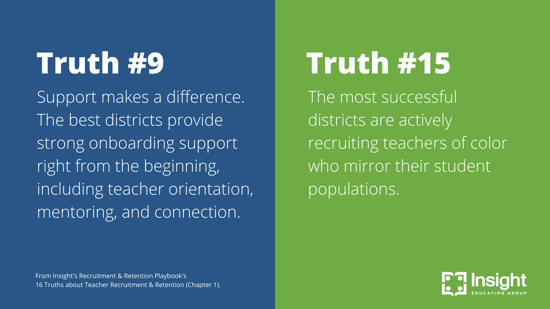
In my work in supporting districts with building teacher recruitment and retention systems across the country, I get the same question from education leaders as we begin our work together: We’re struggling to recruit teachers of color. How do we recruit more?
With an increased focus and urgency by education leaders on equity and race in schools today, leaders are examining data and research about teachers of color with fresh perspectives.
Leaders are seeing the mismatch of demographics between their own students and teaching force—and how it is often mirroring a national trend: Approximately 80% of teachers are White and 51% of public school students are students of color (U.S. Department of Education’s National Center for Education Statistics, 2017-18).
Leaders are also seeing the research about the deep impact and influence that teachers of color have on all students but especially students of color:
- A large study showed that low-income black male students were 39% less likely to drop out by high school if they were assigned to a black teacher in 3rd, 4th, or 5th grade (Gershenson et al., 2017 as cited by Herrmann, 2018).
- Black male students taught by black male teachers are more likely to attend a four-year college (Jacobson, 2018).
- “Teachers of color tend to provide more culturally relevant teaching and better understand the situations that students of color may face” (Dilworth & Coleman, 2014).
But in places where education leaders have been intentional about recruiting teachers of color, there is also more data emerging: an increase in the number of teachers of color leaving versus their White counterparts (Ingersoll, 2018).
According to the report from Education Trust and Teach Plus, If You Listen, We Will Stay: Why Teachers of Color Leave and How to Disrupt Teacher Turnover, several reasons rise to the top as to why teachers of color are leaving their districts and/or education altogether, including:
- Antagonistic school culture,
- Unfavorable work conditions,
- Deprived of agency and autonomy,
- Feeling undervalued, and
- High cost of being a teacher of color, including family situations, societal and cultural inequities, and higher expectations, which takes a toll on them financially and psychologically.
In addition, in many districts, there is a trend to place higher percentages of teachers of color in hard-to-staff, low-income schools with poor leadership and with fewer professional development opportunities—leading to frustration and teachers exiting the district (Mahnken, 2018).
Additionally, findings suggest that black teachers tend to change schools or leave the profession if they aren’t exposed to black colleagues or a principal of color (Mahnken, 2018).
Intentional Support for Teachers Matter
In the Teacher Recruitment and Retention Playbook, I discuss the 16 truths about the state of teacher recruitment and retention in districts today. These truths are interrelated in infinite ways, but this conversation got me thinking about the relationship between two of those truths in particular.
One of those truths is that support for teachers matters and makes a difference in student achievement and retention. The other is that successful districts actively recruit teachers of color.

The relationship between these two truths is illustrated in questions that districts we work with closely are asking themselves: If we actively recruit teachers of color, must we then ensure our support structure has explicit goals around supporting those teachers of color? What if those teachers of color don’t have the certifications or qualifications—do we pursue them anyway?
Data supporting these two individual truths is plentiful.
In terms of teacher support, organizations that prioritize creating and sustaining systems that support employees’ professional growth consistently outperform organizations that do not (Konoske-Graf et al., 2016).
And what keeps teachers in those organizations? The quality of leadership (Amrein-Beardsley, 2012), a quality induction program, and curricular flexibility (Heneman & Milanowski, 2009), among other things.
Most importantly, greater perceived teacher support means greater student achievement. Teachers who feel supported “become more self-actualized to plan and teach more than their counterparts, and are therefore more effective” (Merton, 1948; Hoy, Sweetland, & Smith, 2002; Shaughnessy, 2004).
So, how do we increase and retain diversity in our teaching force? Successful districts need to both recruit teachers of color and aggressively and actively support those teachers of color during their careers.
Retaining with Intention
Districts, however, face many challenges that make this easier said than done. Chief among those challenges is the pressure to produce quickly.
Recruiting and retaining teachers of color can be a slow process: districts often need years to build reputations as organizations that value diversity.
However, with each year that more teachers of color choose to remain is a year that those teachers likely felt supported enough to want to stay. And, if done consistently, helps the organization say to itself, surrounding districts, and prospective teachers, “we value teachers of color.”
This is more than just about recruiting and retaining teachers now. This is also about recruiting and building the potential teaching force of tomorrow. With 51% of the student population in public schools being students of color, many districts are beginning “grow your own” programs—a long-term teacher pipeline strategy— to create pathways for their own students of color to become teachers in their districts one day.
Taking a Reflective Approach
How do districts realize this very long-term investment in becoming known for creating positive work environments for teachers of color?
To begin, school and district leaders must first take time for deep reflection on their personal biases and their institution’s history with race. In addition, it requires regular and intentional conversation around current demographic data, the experiences of current educators of color, and current practices to recruit and retain teachers of color.
In turn, these reflections can lead to amazing new levels of opportunity, achievement, performance, support, and belonging for teachers of color as well as their students.
Reflection Questions for District & School Leaders
Below are some recommended questions for leadership teams to engage in reflection and dialogue.
Keep in mind: As with many questions, there are no simple answers. Rather, the quest for answers often leads to more questions. But luckily, this quest for answers is itself a productive process, and it is ultimately beneficial for your district and your students to persist in this quest.
The more you ask and try to answer these questions as leaders, the more likely that you will institute structures, habits, and mindsets that are critical for the year-round effort that is teacher recruitment and retention—and ultimately positively change the trajectory for all your students.
- Look at your district’s demographic data for students, professional staff (teachers, teacher leaders, school leaders, central office staff, district leaders), and non-professional staff (employees in security, custodial, food services, operations, etc.)
- What surprises you?
- What is most alarming to you?
- Is there a difference in demographics between your exempt vs. non-exempt staff?
- What are the implications of these statistics on providing equitable outcomes?
- What circumstances have led to these inequities?
- How is your district actively recruiting, promoting, and retaining leaders of color in all levels of your organization?
- Why are your teachers of color leaving? Why are current teachers of color staying?
- How have you listened to the voices of teachers of color in your district? If so, what have you learned?
- How do you plan to regularly listen to the voices of teachers of color?
- Have you intentionally asked your teachers of color to stay through practices such as stay interviews?
- Have you asked prospective candidates of color to provide feedback on your recruitment efforts?
- How can your teachers of color inform and provide support and feedback in teacher recruitment efforts?
- When was the last time you examined hiring practices to look for implicit bias—including how and where positions are marketed and posted, where you are recruiting from, how you are recruiting at in-person events, consistency and alignment of interview processes for all hiring managers, and how final hiring decisions are made?
- In what ways are you/can you support teachers of color in the classroom and moving into leadership roles?
- How is your district promoting and supporting professional and personal growth in their areas of race, diversity, and inclusion for its employees?
- What kinds of professional development are you offering all educators to develop cultural competency?
- What kinds of activities are you employing for and/or with your staff that reflect cultural competency?
- How does your district’s strategic plan speak to some of the issues you have raised already in this conversation? Does it need to be revised or looked at again?
- What activities are regularly planned and supported to facilitate opportunities to build community for and among teachers of color?
- What questions above should we revisit each year?
(Special thanks to Tim Suba for his collaboration on this blog post.)

